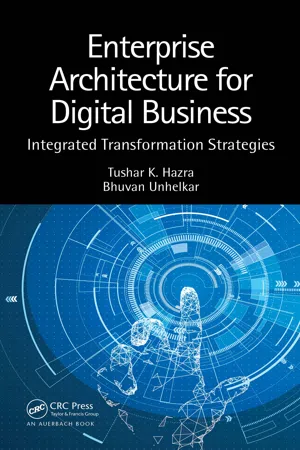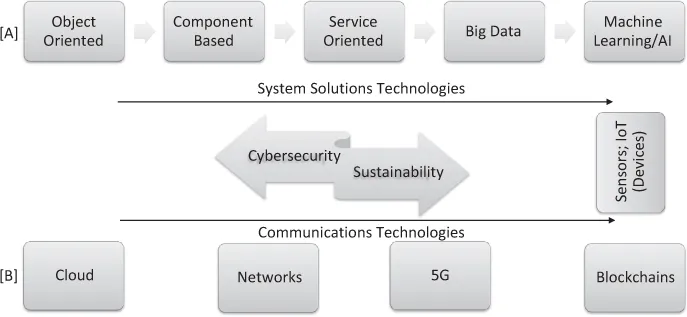
Enterprise Architecture for Digital Business
Integrated Transformation Strategies
Tushar K. Hazra, Bhuvan Unhelkar
- 282 pages
- English
- ePUB (mobile friendly)
- Available on iOS & Android
Enterprise Architecture for Digital Business
Integrated Transformation Strategies
Tushar K. Hazra, Bhuvan Unhelkar
About This Book
Enterprise Architecture (EA) is an essential part of the fabric of a business; however, EA also transcends and transforms technology and moves it into the business space. Therefore, EA needs to be discussed in an integrated, holistic, and comprehensive manner. Only such an integrated approach to EA can provide the foundation for a transformation that readies the business for the myriad enterprise-wide challenges it will face. Highly disruptive technologies such as Big Data, Machine Learning, and Mobile and Cloud Computing require a fine balance between their business and technical aspects as an organization moves forward with its digital transformation. This book focuses on preparing all organizations – large and small – and those wishing to move into them for the impact of leveraging these emerging, disruptive, and innovative technologies within the EA framework.
Frequently asked questions
Information
Part A
Setting the Context for Digital Business
1 Digital Business, Enterprise Architecture, and the Transformation Imperative
What is Digital Business?

- Data related to all business functions is collected, stored, and secured, ensuring that the business is able to gather a wide variety and large amount of data that they may not have otherwise.
- Business decisions are driven by Data Analytics rather than by the intuition of the senior-most decision makers of the organization. Such scientific method reduces biases in decisions.
- Customers are connected electronically with the business, enabling them to operate at any time of the day or night and at any location (especially when mobility compliments electronic connectivity). Customers are also able to receive personalized service as the digital business is able to precisely identify their needs and provide for it.
- Other firms collaborate digitally with the business, enabling a wider expansion of offerings and providing opportunities to capitalize on the needs of the partner company’s customers. Collaborations on electronic/mobile platforms also enable process optimization.
- Digitizing records makes it easier for businesses to adhere to Governance-Risk-Compliance mandates, than if they were managed on paper. Storing the records and reporting them electronically to legal and audit authorities simplifies business processes and provides clear audit trails.
- All business functions are optimized through digital technologies – including sales, marketing, inventory, accounting, and human resources.
Digitization Landscape and Opportunities
- What opportunities does DT bring to the business?
- Will digitization enhance the user experience for both consumers and employees?
- Will digitalization enable enterprise agility?
- What are the efforts and corresponding risks in DT?
- What are key criteria to ensure successful change management?
- Which digital business processes will be automated and which will be optimized?
- How will digitization impact sustainability?
- How does digital technology enhance communication and collaboration amongst business partners?
- How will digitization ensure compliance?
- Which system solutions will transition to the Cloud?
- Where will the data be stored (data privacy and security)?
- How will data be provided to business functions?
- What is the role of EA in undertaking DT?
- How will the success of DT be measured (metrics/KPIs)?
- Is DT a technology initiative?

- Object Oriented Technologies were a major revolution in solutions development technologies as they enabled faster time-to-market for IT solutions and, through the application of encapsulation, higher quality.
- Component Based Technologies encapsulated a group of objects in design, implementation, and execution, leading to an even faster time-to-market for the IT solution. These technologies were not as nimble as the Object-Oriented ones due to larger-sized components, leading to challenges in maintenance and operation.
- Service Oriented Technologies enabled offering of components over the internet, making it easier and faster for solutions to be developed using the services created by other providers in real time. Service Oriented Architecture (SOA) changed the landscape of providing solutions from component-based, single-site to a collaborative suite of services.
- Big Data, and data in general, made it possible for businesses to collect information they could not earlier and store it for processing. Big Data and Analytics develop a comprehensive view of different master data management elements (e.g., customers, products).
- Machine Learning (ML) enabled businesses to undertake data-driven decision-making. This is so because ML/AI makes it possible to derive insights from Big Data. ML capabilities (e.g., process mining) can extend enterprise systems’ capabilities.
- Cloud – and Associated Storages – was a game changer for the digitization landscape as it eliminated the administration and management of routine data functions from the business and shifted it elsewhere, leaving the business to focus on its core competencies.
- Networks, local and global, played a crucial role in the digitization of a business by providing connectivity.
- 5G and Mobile made it possible to shift analytics and processing from a fixed location to being completely location-independent.
- Blockchains offered another game-changing opportunity for digital business by providing a high level of veracity of data and analytics. This is due to blockchains’ potential to provide highly secured and validated data – especially after integration with existing enterprise systems. Blockchain technology also impacts the governance of information stored in enterprise systems.
- Sensors – Internet of Things (IoT) and Internet of Everything (IoE) – enabled collection of data with or without specific input from users. A number of IoT sensors collect massive amount of data associated with the business and/or the government and make it available for processing.
- Cybersecurity and Sustainability are the two important underlying architectural considerations in the overall landscape of digital era technologies.
Contemporary Digital Technologies and their Impact on Digital Transformation
Digital Technology | Description | Digital Transformation Consideration |
|---|---|---|
IoT (Internet of Things) IoE (Internet of Everything). IoT can be personal or industrial. | Enables non-stop sour... |
Table of contents
- Cover
- Half Title
- Title Page
- Copyright Page
- Dedication
- Table of Contents
- List of Figures
- List of Tables
- Foreword
- Preface
- Acknowledgements
- Authors
- Part A Setting the Context for Digital Business
- Part B The Digital Enterprise Architecture Life Cycle
- Part C Leveraging the Value of Digital Enterprise Architecture
- Appendix A: Use Cases in EA and Digital Business
- Index